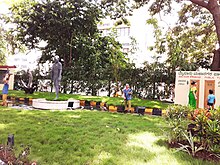This article may require cleanup to meet Wikipedia's quality standards. The specific problem is: Title misspelled, should be Hardings (Needs evidence of how should be spelled). (March 2021) |
12°18′25″N 76°39′37″E / 12.307065°N 76.660200°E


Jayachamarajendra Circle or Jayachamarajendra Wadiyar Circle, formerly known as Harding Circle or Arugatu is an intersection of six major roads in Mysore, Karnataka state, India.
Etymology
editThe circle was originally called Hardings Circle. The locals preferred to call it Aru Gate because six gates converged in the circle leading to six main roads of the city.
The western road leading to the Mysore Palace and city bus station is called the Albert Victor Road. The two northern roads are called Bangalore Nilgiri Road as they are both one-way-twins leading to Bangalore. The southern road is called Nilgiri Road which goes to Ooty. The eastern road is called Mirza Road and it goes to Postal Training Center in Nazrabad. The southeastern road is called Lokarjan Mahal road and it goes to the Mysore Zoo and Karanji Lake.[1]
Statue
editIn 2016, a lifesize statue of Sri Jayachamarajendra Wadiyarwas erected at this intersection. The statue was made in Indo-Saracenic architecture. The cost of construction was Rs. 5 crores. it is the third largest statue in Mysore.[2]
The statue was unveiled by the chief minister of Karnataka in July 2016.[3][4] The 28-ton statue was made by a Mysorean sculptor Arun Yogiraj shilpi.[5]
Image gallery
edit-
The Clock Tower
-
Freemason Hall
-
Mansoor Dargah
-
Harsha Street
-
Kuppanna Park
-
Gandhi Market
-
Suburban Bus Station
References
edit- ^ "Google Maps".
- ^ Bennur, Shankar (11 January 2015). "A tribute to Mysore's last Maharaja". The Hindu.
- ^ "Jayachamarajendra Wadiyar's statue to see light of day, finally". 16 July 2016.
- ^ http://karnatakavarthe.org/en/cm-unveiled-the-statue-of-sri-maharaja-jayachamarajendra-wadiyar-and-dedicated-newly-developed-hardinge-circle-in-mysuru/ [dead link]
- ^ "Famed Mysuru gets another royal era statue". 17 July 2016.